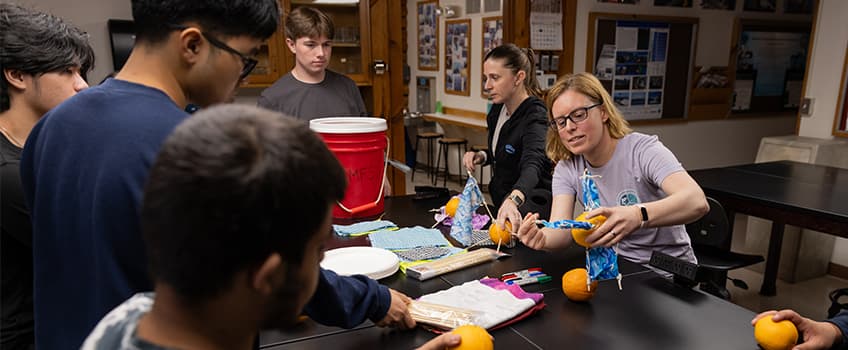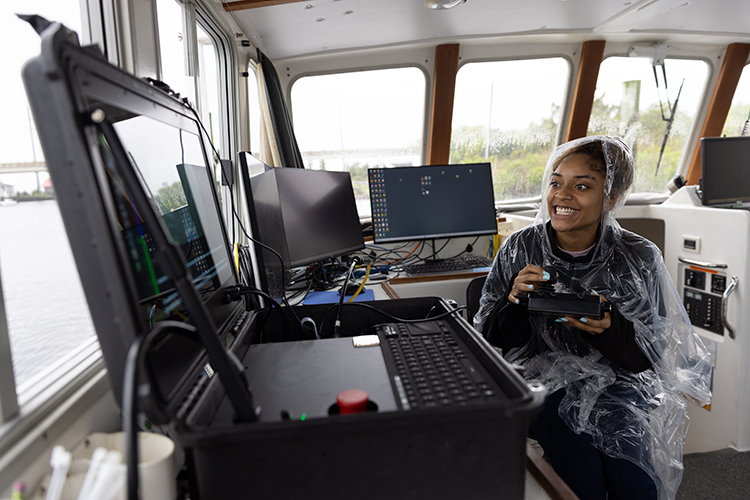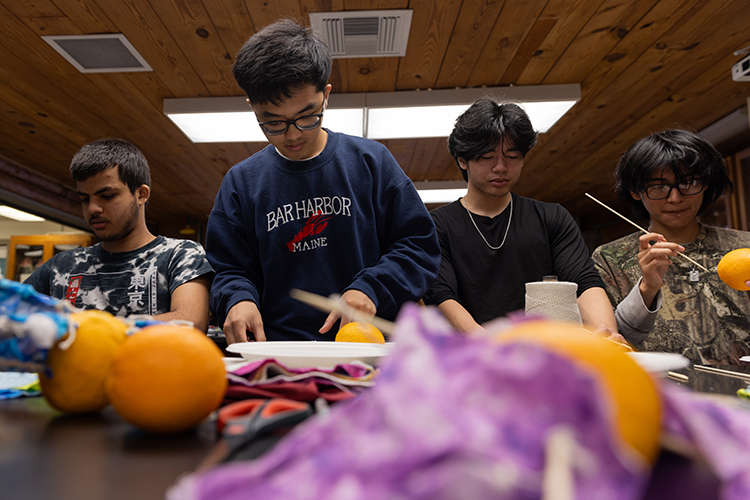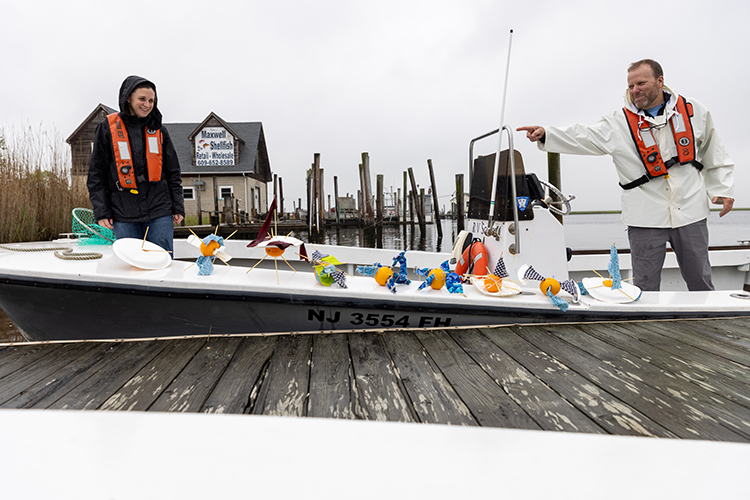H.S. Students Get Hands-On Look at Marine Field Station's Work

Stockton junior Sean Duffy, of Jackson Township, center, joins Christie Thompson and Anna Pfeiffer-Herbert, both associate professors of Marine Science, to work with a group of students from Atlantic City High School at Stockton's Marine Field Station on May 16.
Port Republic, N.J. — Denise Jenkins shrieked as one of her fellow Atlantic City High School students pulled the metal crab pot on board the boat.
The Atlantic City native didn’t expect the trap to be filled with blue crabs. The first cage the Stockton University professors removed from Nacote Creek on a recent rainy and gloomy day only had one of the crawly critters.
But not this one. Eight crustaceans of various sizes greeted Jenkins, and now she could get close enough to touch them.
“I'm not gonna lie, it was amazing,” said the 16-year-old.
 .
.
Denise Jenkins, of Atlantic City, tries to ‘fly’ one of Stockton’s new underwater remote operated vehicles at Stockton’s Marine Field Station on the Nacote Creek in Port Republic.
Jenkins was one of about 20 marine and environmental science students from two classes taught by Emily Loeb ’23 to take a tour of Stockton’s Marine Field Station on May 16.
The outreach is an educational component of three research studies by three Stockton professors. Students helped build water drifters with Anna Pfeiffer-Herbert, “flew” a new underwater remote operated vehicle (ROVs) with Peter Staub and used sonar to identify shipwrecks and marine debris with Stephen Nagiewicz and Mark Sullivan.
Jenkins and several of her classmates were impressed.
“My favorite part was being on the boat because we got to see all the things (the professors) do and how they use the equipment to explore,” Jenkins said. “It was a great experience for all of us together. It was a chance for us to get out and see something different.”
And that was one of the main reasons Loeb reached out to Nagiewicz, a Marine Science adjunct professor, to set up the visit.
“Most of them have never had a hands-on experience with marine science,” said the Biology graduate who replaced Nagiewicz after he retired from ACHS last year. “It’s very hard to do labs for marine science in the classroom because we have such limited time. Plus, probably more than half of my kids have never been on a boat, so this is a first for them today.”
Exposing potentially college-bound students to the wonders of oceanography is one of the biggest joys Pfeiffer-Herbert gets out of visits like this one.
“From my own personal experience, I didn’t know that oceanography existed until I was most of the way through (Carleton College in Minnesota) and we didn’t have an oceanography program,” said the associate professor of Marine Science, also known as Dr. PH by her students and co-workers. “So, part of this is just the awareness of what it is that we do and why it’s important.
“I also think that the more students get a chance to be outdoors, you get to see the fun part of the work and the real stuff of what we do and connect to the local environment.”

From left, Atlantic City High School students Fahad Malik, Devin Huynh, Alexander Tran and Brandon Lopez-Lopez work to construct "low-tech" drifters out of oranges.
Manning the controls of one of Stockton’s new ROVs was the most fun part for Hannah Frebowitz. The vehicle was purchased as part of a $500,000 grant Stockton received last year from the National Oceanic and Atmospheric Administration.
The Margate native grasped the remote control of Defender from the cabin of the R/V Petrel while it was docked at the field station. She directed the vehicle along the bottom of the creek and spotted several clam shells, while being careful not to stir up too much sediment that might obscure the ROVs camera.
“It was really cool because you not only get to see above the water but also the world below, which is a whole other experience,” said the 18-year-old senior.
Frebowitz was also part of the first group that helped build a drifter to track water currents as part of a $150,000 grant from the U.S. Coastal Research Program.
The “middle-tech” drifter is fitted with a float to stay on top of the water, solar panels to provide power and a GPS tracker to transmit data. Frebowitz and her classmates also constructed “low-tech” drifters using oranges. Pfeiffer-Herbert encouraged the students to get creative by placing skewers in their oranges to improve stability, cardboard plates to increase the orange’s surface area and buoyancy and pieces of cloth to help the drifter catch water currents more easily.
“Does it float? Does it stay upright? Does it catch the current or the wind?” Pfeiffer-Herbert explained to the students. “You don’t want a lot of wind. You want it to catch the current, not the wind. You want it to float just on the surface.”

Christine Thompson, left, and Steve Evert, the director of Stockton's Marine Field Station stretch out the homemade floaters the Atlantic City High School students made during their visit.
Stockton junior Kyle Dantas helped the students put the drifter circuit board together. The 19-year-old from Little Egg Harbor Township loved the opportunity to do some outreach with high school students for the first time.
“It’s nice to try and convince some students to go into this field because it’s a field that’s very important,” said the Marine Science major with a concentration in Oceanography. “We need more people in the field, and I enjoyed observing the students just being generally interested.”
Exposing high school students to the diversity of jobs in the marine science field is a big reason why Stockton has continued to host these events, said Steve Evert, the director of the Marine Field Station.
“Career opportunities in marine science are growing in areas like hydrography and coastal resilience sciences,” Evert said. “The grant funding our faculty have received has helped us keep pace with our offerings both in terms of advanced equipment and programming.”
After testing to see if their orange drifters floated in a sink full of water, the Atlantic City students took their oranges to the creek for a “race” to see which one floated the farthest. To his great surprise, senior Aaron Simpson’s drifter won.
“I didn’t even know the marine field station was here,” said the Brigantine native who’s enrolling in Stockton in the fall as an Environmental Studies major. “It was really neat to see the classroom and the facilities that Stockton has here. There are a lot of opportunities in marine science, and it was cool to discover that Stockton has all of this for us.”
And don’t forget that science can be fun, Loeb said.
“Stopping at an osprey nest, using the sonar to view a shipwreck, pulling up two crab pots themselves and touching the crabs — they loved it,” she said. “They were on their phones videoing themselves, screaming and yelling with excitement. They were just so excited. I would say this day has been pure joy for them.”
— Story by Mark Melhorn, photos by Susan Allen


